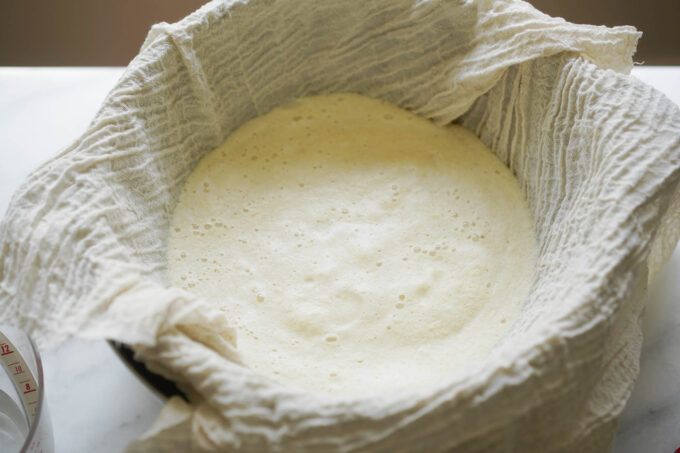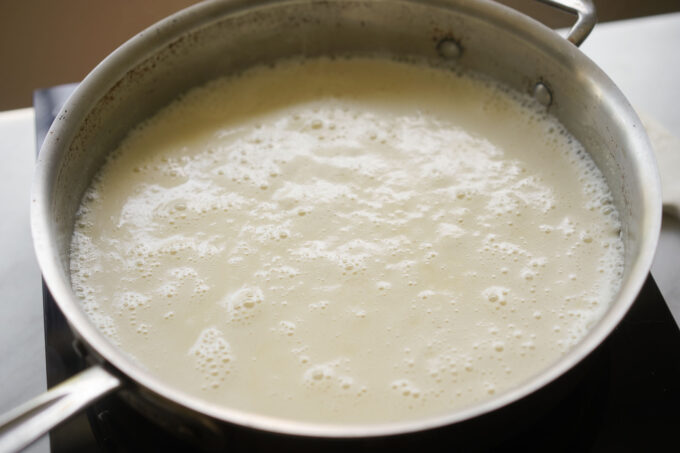Can you hear the taho seller in Manila streets belting out for you to try a cup of this classic Filipino merienda snack? Each cup is filled with silky and soft pieces of tofu layered between sago pearls and swimming in a sweet syrupy “arnibal” sauce.
I will always remember visiting the Philippines and hearing “Tahoooo! Tahoooo!” from the taho man selling them on the streets. His big tubs of tofu, arnibal, and sago pearls balancing between his shoulders were always welcomed by my mom with pesos in her hand ready to collect her snack mid-shopping spree.

Background
It’s been said that taho was influenced by Chinese migrants in pre-colonial Philippines and originated in the form of douhua–a similar snack of soybean pudding and syrup. In Vietnam, they also have a similar version that uses silken tofu and a syrup with a ginger base called dau hũ nước đường. These days there are many versions of taho that include flavors like ube, pandan, or strawberry syrup.
What’s great about making your own taho at home is that you can adjust the sweetness level of the arnibal sauce and the ratio of silken tofu and pearls added–it’s completely customizable! With this recipe, you’ll also learn how to make your own homemade soy milk and silken tofu that makes a super fresh taho snack.
Homemade soy milk and silken tofu

Why homemade soy milk and silken tofu? Well honestly, why not! Thanks to this soy milk and silken tofu recipe from Serious Eats, I was able to learn and adjust the recipe as I went along. Making soy milk and silken tofu only takes three ingredients: soybeans (I like using organic soybeans), water, and epsom salt.

The only thing you need to remember is to soak the soybeans overnight before starting this recipe. Like any recipe, you also have the option of buying premade silken tofu at your local Asian grocery store to save time too! I am lucky enough to have local stores that sell fresh silken tofu in little Saigon, but you can also find them at stores like HMart or even Albertsons.
Arnibal and pearls
Arnibal in Tagalog means sweet syrup and this is what is layered in between tofu and pearls. It’s a light syrup that you can adjust based on your preference. For this recipe, I liked to cook it down slightly to get a concentrated flavor.
Sago pearls are traditionally used in taho. Sago is different from white tapioca pearls because it’s made using starch that is extracted from the pith of a sago palm whereas white tapioca pearls are made from cassava starch. You can use either sago or tapioca pearls in this recipe.

An interesting thing I’ve seen at US grocery stores is that labels for sago and white tapioca pearls are interchangeable. Typically I look at the ingredient list and many of these bags list cassava starch, which means they’re really tapioca pearls.
I would also note that sometimes people use boba pearls, which are made to be chewier for boba milk teas, but I prefer using traditional white tapioca or sago pearls. White tapioca and sago pearls have a texture that is less chewy and more similar to sago pearls.
For this recipe, I am using my 30 and 30 method for cooking white tapioca pearls. Like most tapioca pearls (that are not meant for boba milk tea), I had to repeat the 30 and 30 method twice to fully cook the pearls and turn them translucent. I kept the cooked pearls in water while I waited to assemble the taho.
Cooking tips

- Use a thermometer. This helps tell you when to pull the pan off the stove. We removed the pan at around 200 °F (just before boiling).
- Stir consistently and do not leave your pan unattended. Soy milk has a tendency to develop a thin skin at the top of the pot, so you want to continue to stir while it’s cooking.
- Before adding the epsom salt, measure the amount of soy milk you have to cook. Sometimes you don’t end up with the same amount of soy milk in cups and need to adjust the ratio of epsom salt. Adding too much salt can change the texture of the tofu. The ratio should be 3 cups soy milk to ½ teaspoon epsom salt.
- Wrap your lid with a cheesecloth before steaming to make sure no water gets into the tofu.
- Different sized ramekins have different cooking times. For a 3-inch diameter ramekin, the cooking time in the water bath was around 10 minutes. Anything larger will increase the water bath timing.
What is taho in Chinese?
The Chinese version of taho (also known to be it’s original form) is called douhua, which has soy bean pudding or silken tofu and a sugar syrup.
How much is taho in the Philippines?
Taho is a very inexpensive snack in the Philippines and is often sold on the street by a taho vendor known for yelling “taho!” in the streets. You can find it for well under 50 pesos.
Is taho a soya?
One of the main ingredients of taho is silken tofu, which is made from soybeans.
Can you reheat taho?
It’s best to keep the silken tofu and the arnibal and sago/tapioca pearls separated if you cannot finish it. You can reheat the tofu over a steamer and it won’t disintegrate in the microwave.

Taho (Filipino Silken Tofu w/ Sago Pearls & Syrup)
Ingredients
Silken tofu
- 1 c soybeans
- 6 c filtered water for soaking
- 1 c filtered water for blending
- 2 c filtered water for cooking
- ½ c filtered water for squeezing
- ½ tsp epsom salt
- 2 tbsp filtered water for tofu
Pearls
- ⅓ c dry sago or white tapioca pearls
- 8 c filtered water
Traditional arnibal / syrup (Option A)
- ¾ c dark brown sugar
- ¾ c filtered water
Pandan arnibal / syrup (Option B)
- ¾ c pandan water
- ½ c white granulated sugar
Equipment Used
- cheese cloth
- ramekins or small bowls
Instructions
Silken tofu
- Rinse the soybeans over running water and drain. In a large mixing bowl, combine soybeans and 6 cups of water to soak overnight (or at least 8 hours) on the counter. The next day, the soybeans should double in size.
- Drain and rinse the soybeans then transfer to a blender with 1 cup of filtered water. Blend until the soybeans puree into a smooth consistency.
- In a saucepan over medium heat, add the soybean puree and stir in 2 cups filtered water. Cook and stir until the puree is JUST about to boil or at 200 °F. Constantly stir the soybean puree. Do not leave your pot unattended because it will burn at the bottom.
- Set-up a strainer lined with cheesecloth over a bowl and pour in the cooked liquid.
- Strain the soybean puree carefully by squeezing out the liquid through the cheesecloth. I like to use silicone gloves during this portion.
- After squeezing out as much as you can, open the cheesecloth and pour ½ cup of water over the soybean puree and squeeze the cheesecloth again. The soymilk should measure to about 2 cups. See picture for what the soy looks like after squeezing.
- Clean your saucepan and place it over medium heat and pour in the soybean liquid. Bring to a boil and cook for about 7-10 minutes or until the raw taste is gone and it’s more sweet.
- Remove from the heat and cool on the counter before transferring to heat safe containers. Move to the fridge to chill for 30-60 minutes. If you want it faster you can chill using an ice bath.
- Combine the epsom salt and 2 tbsp of water until the salt dissolves. If you squeezed out a different amount of liquid than 2 cups, make sure to adjust your salt accordingly.
- Pour the salt liquid carefully into your chilled soymilk and use a spoon to do 3-4 gentle “plunging” motions to mix the salt liquid into the soymilk. You don’t want to overstir the coagulant because this could change the texture of your tofu.
- Pour your soymilk into the heatsafe ramekins no more than ¾ of the way up, and place them in a pan large enough to hold all the ramekins. Fill the pan with simmering water until it reaches slightly above the level of the soymilk. You don’t want the water coming too close to the rims because it might overflow into the soymilk. Cover the pan with a lid that is lined with a hand towel to prevent water dripping into the ramekins. Simmer for about 10 minutes or until the tofu is firm. Note: I used ramekins that were about 3 inches in diameter and 10 minutes was enough to set the tofu. If you use larger ramekins, the cooking time will need to change.
- Carefully remove the ramekins from the water bath and let them come to room temperature on the counter before assembly.
Pearls
- In a pot, add the water and bring to a boil. Pour in the tapioca pearls and lower to medium heat. Stir the pearls to prevent them from sticking and cook for 30 minutes.
- Remove the pot from the heat and cover with a lid for another 30 minutes.
- Drain the pearls and rinse with cold running water.
- The pearls should be translucent and soft. Transfer them into a bowl with water covering just above the pearls and set them aside until assembly. Note: if your pearls still have an opaque center and/or are hard in the center, repeat steps 1-3.
Arnibal
- Choose one of the arnibal options above. In a small saucepan over medium heat, combine the sugar and water and bring to a boil. Lower to medium heat and simmer for about 5 minutes to slightly thicken the sauce. Remove from the heat and set aside until assembly.
Assembly
- Taho is typically served warm. If the tofu is too cold for your liking, you can heat it up in a steamer for one to two minutes (but not too long otherwise it will dry out too much). Add a few scoops of tofu into a cup.
- Add 1-2 tablespoons of pearls into the cup and top with arnibal. Serve warm.














